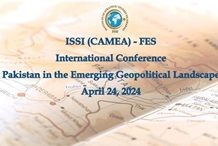Pakistan-China relations are a shining example of two countries living in peace. High-level official visits between Pakistan and China are a glorious tradition.
On his maiden overseas visit, Pakistani President Mamnoon Hussain paid an official visit to China this week. He held talks with Chinese President Xi Jinping, and met with Premier Li Keqiang and Chairman of the Standing Committee of the National People’s Congress Zhang Dejiang, as well as interacting with other leaders and government functionaries.
Both countries are determined to carry out plans for the China-Pakistan Economic Corridor (CPEC). Since July 2013, both countries have been working on modalities of this project that aims at linking western China with the Gwadar deep sea port in Balochistan Province of Pakistan, close to the Persian Gulf, a new land route to connect China with the Gulf.
The multi-billion dollar CPEC is in the process of discussion. The CPEC means true regional integration from a much broader perspective.
The first phase of the Gwader port was built with Chinese assistance worth $248 million. The port was inaugurated for shipping in 2007 that was initially managed by a Singaporean company.
In February 2013, the ports’ leasing rights were, however, transferred to the China Overseas Port Holding Company.
The Joint Cooperation Committee (JCC) has been set up to tackle the jointly agreed projects of the CPEC. The second meeting of the JCC was held in Beijing on Tuesday.
There are many joint committees and commissions working between the two countries to strengthen bilateral economic relations.
The cordiality of Pakistan-China friendship dates back to the establishment of the PRC in October 1949. Pakistan was one of the first countries to recognize the PRC as early as January 1950, and established diplomatic relations with China in May 1951.
Similarly, high-level exchanges between the two countries were initiated in the late 1950s at the peak of the Cold War tension when Pakistani prime minister Hussain Shaheed Suhrawardy paid a visit to China in October 1956 and Chinese premier Zhou Enlai visited Pakistan in December same year within the spirit of the Bandung Conference and good neighborhood.
The boundary agreement of 1963 stands out as a shining example that how disputes can be amicably resolved between neighbors.
Since then, high-level visits have become a common feature of friendship between the two countries. Today both countries are trying to bolster economic ties to new unprecedented heights.
Bilateral trade has crossed the barrier of $12 billion in 2012. In 2008, bilateral trade was only around $4.6 billion.
The greater the level of trade between the two countries, the greater the level of investment between the two. To promote investment between Pakistan and China, trade should be more expanded.
Investments between the two countries need to be strengthened. If Pakistan overcame its security problems, China could increase its investments, which have been adversely affected by security woes. The proposed CPEC could attract huge investment from China, but Pakistan needs to make the institutional arrangements to back this up.
Strategic concerns and threats regarding the building of the CPEC will not affect the project as both China and Pakistan seek a common goal to uplift the region. China has the full capacity to deal with separatist tendencies in Xinjiang and Pakistan has been dealing with terrorist groups in the tribal belt and Balochistan through a peace process.
Views expressed are of the author and do not necessarily reflect the views of ISS or of the Government of Pakistan.












